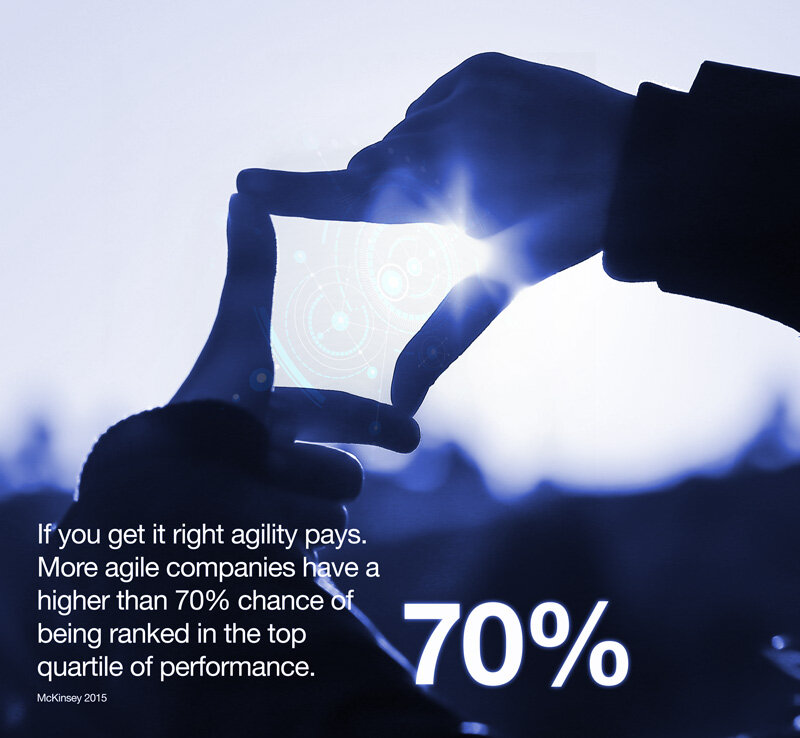Agility pays
Digital disruption impacts the way products are marketed, bought and serviced, blurring the edges between online and offline experiences. For corporate innovators, this means they need to focus on not just reinventing the product but also the end-to-end consumer experience and business model to stay relevant.
Also, it can be hard - especially for large corporations - to keep pace with ever demanding consumers and exploit new technologies in real time to strengthen brand relationships.
In this context, being more consumer-centric, collaborative and agile is not a nice to have, but a C-suite imperative because the traditional silo-based ways of working are slow and not flexible enough.
It is often said there is no shortage of ideas - it’s spotting the ones based on a genuine insight, and how to optimise them that preoccupies innovation teams. And if that wasn’t enough to contend with, overlay a more dynamic innovation landscape that needs navigating:
The innovation tempo is increasing: cycle times are reducing, and demands from the business and retailers to up the pace can result in decisions being made based on less insight and rigour.
Innovation is no longer just about the product: it’s the ability to create a multifaceted consumer experience - facilitated by digital transformation.
To advance your innovation success rate, put your consumer first by adopting human-centred insight and agile idea generation techniques to deliver more favourable outcomes.
AGILITY PAYS
More agile companies have a higher than 70% chance of being ranked in the top quartile of performance.
Moreover, an innovation benchmark survey by PwC in 2016 found that nearly twice as many companies now favour the more user-centred and collaborative models of open innovation, design thinking and co-creation vs the traditional R&D models.
In fact PwC found there is no statistical relationship between dollars spent on R&D and financial performance - how you spend your money is more important than how much you spend. Culture, behaviour and fresh thinking are seen as more important than increasing the innovation budget when it comes to innovation success factors.
Agility, co-creation and experimentation are indispensable for not only disruptive innovation but also keeping your core business fresh and relevant.
Companies that employ design thinking and user-driven requirements from ideation to product/ service launch are twice as likely to expect growth of 15% or more over the next five years vs their peers. McKinsey 2015.
How to respond to dynamic times?
Here are some of our practical tips on how to rise to these innovation challenges.
EMBRACE DESIGN THINKING
While design thinking, consumer co-creation and rapid prototyping methods may have been the realm of startups and tech companies in the past, they are now much more mainstream and an integral part of the innovator's toolkit across many sectors: consumer goods, healthcare, banking, retail. In fact the top 10 leading MBA programs now teach design thinking.
The design thinking approach puts the user - and their needs - front and centre of the ideation process. It involves small cross-functional teams working in a series of iterative learning sprints - unlocking overlooked insights, exploring and testing ideas via prototypes and co-creating with users.
Through iterative experiments, the multidisciplinary team look at proposed solutions through the lens of consumer need, but also organisational feasibility.
So, in a nutshell, design thinking is collaborative, encourages rapid experimentation and unlocks a more vivid understanding of how you can help your consumer achieve their goals.
STRATEGIC OVERSIGHT THAT IS MORE RESPONSIVE
Agile innovation doesn’t equate to the wild west of small skunkworks going off and working on whatever they want!
Ensure each team has a deliberate purpose and scope aligned to your business and brand strategies, and secure appropriate resources as part of your portfolio management governance.
Establish procedures and practices that support increased experimentation, which are not overly bureaucratic or ‘top-down’, otherwise the team will be destined to fail.
Team members should be empowered, and have these projects built into their performance metrics, i.e. this shouldn’t be a bolt on to their day job - otherwise you won’t get focus.
A disciplined approach provides focus and unlocks creativity.
SPRINTING PIZZA TEAMS
The best teams comprise a core of 4 to 8 members that conform to the Jeff Bezos two pizza rule, i.e. a group which isn’t larger than what two pizzas can feed.
Importantly these should include diverse viewpoints and functional expertise. A study by Nielsen showed that consumer product concepts created by teams with members from several business functions outperform those designed by teams from just one functional group.
Ensure that you have a mix of personality types and those who feel comfortable with ambiguity and are curious, as well as a balance of thinkers and doers.
Each phase of work should be broken down into short sprints, typically no more than four weeks duration. The team will work best with plenty of face to face time via collaborative workshops and tasks.
An essential part of collaboration is the breaking down of functional silos, and the chance for folks to get together in person to incubate nascent ideas, ask surprising questions, share viewpoints and kick the tyres on unsolved hunches (could we make it at this price; how are we going to talk about this idea at different moments along the consumer journey; we can't make this claim, but what if were to say...).
A benefit of time-bound sprints is that you fail - but importantly learn - fast. And as Frederik Pferdt, Chief Innovation Evangelist at Google says, ‘It doesn’t feel like a failure if you learn in a week.
CO-CREATE & EXPERIMENT
Agile teams create ideas through hypothesis testing and experimentation, with people learning what works through trial and error - a process referred to by Henry Mintzberg as emergent strategy.
Contrast this with the more traditional stage-gate process where a marketing team might have spent months synthesising insight frameworks, then brainstormed concepts and thrown a shortlist into an online consumer test to see which surfaced to the top. The winning ideas would be handed over to an operational project team to see if they can make it.
The flaw in this process was that ideas weren’t ‘co-created’ up front. The supply-side of the business (finance, R&D, legal, operations, supply chain, category) only got involved once the demand side had conceived the opportunity. Only when the full project team got together did everyone’s attention focus on the idea, and the practical constraints spotted (manufacturing, technical, regulatory, sales) with the result that the original concept gets watered down into something that doesn't reflect what the consumers loved.
This approach worked when categories were more stable, and there were fewer variables to manage.
Contrast this with successful innovators who involve the customer throughout the innovation process and break down the silos between functional departments (R&D, Sales, Marketing, Operations, Regulatory and so forth) to ensure better collaboration and co-creation to get more holistic and imaginative ideas to market, sooner.
Ramping up co-creation and prototyping upfront benefits teams in several ways:
The team quickly capture all perspectives early because stakeholders are collaborating and co-creating solutions.
Consumers are brought in at the start and throughout the process to help. While consumers may struggle to tell you what they want, they can certainly tell you what their frustrations are and what they are trying to achieve. When exposed to iterations of early prototypes consumers can spot the flaws and help create a much more integrated and relevant solution to address their needs.
Best in class companies will also involve their suppliers, business partners and retailers to co-create solutions.
These speedy iterations help the team to scrutinise critical questions: what is the real problem we are solving here? How does the idea solve the customers' need? How do we make this real and unique? What capability do we need to implement this? How does this impact our business model? What’s the quickest way we can get a beta version of this to market to learn fast?
With each iteration, the team move closer to a tangible, workable solution. The benefit:
more original and vivid users insights
more concrete and actionable ideas
faster execution, because people detect operational issues in the early design phase
it boosts creativity and team building
ACT NOW
If you find your innovation track record is lacklustre, ask:
Are we putting in place more agile innovation methods?
How can we encourage greater collaboration and cross pollination of ideas?
Are we looking at the holistic consumer experience?
How can we test 'n learn more rapidly?


